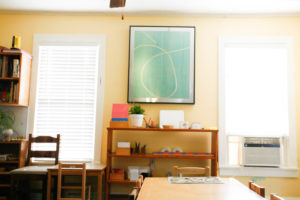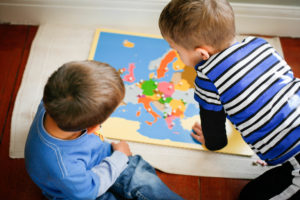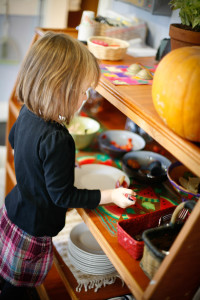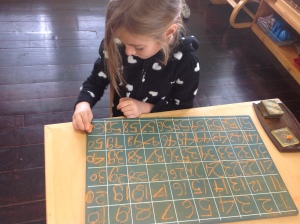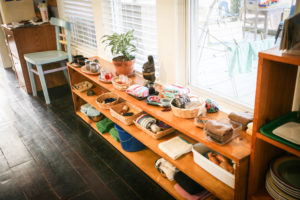Observations
Observing the Montessori classroom is often done before enrolling as well as once your child is a student at La Casa dei Bambini. The following sections gives you some idea of what you can expect to do and see as well as some general guidelines that will help our classroom run smoothly when you visit.
Guidelines for Parents Observing the Classroom Before Enrolling
Observations are scheduled for approximately at least 20 minutes during the morning work cycle. To ensure that the classroom does not become overcrowded with visitors, this observation must be scheduled in advance. Please call us at 512.262.2999 to schedule a visit.
We want to make sure that you are able to get a feel for the school and that our children are able to work as normal. Keep in mind that our guides may be working with children so they may not be able to greet you. You are still very welcome but it is important that the children can depend on their morning routine.
Please follow these guidelines when you visit:
- When you come into the classroom please look for the grown-up chairs and sit in any that are available. Children are used to coming to the adults sitting on the chair for assistance, please redirect them to us if they ask you for help.
- While you are visiting we ask for you not to engage in a conversation with the children or ask them questions about their work. They are not familiar with you and they might not feel comfortable.
Here a some Montessori principals in action that you should be able to observe:
- Meaningful Work – Notice the purposeful activities that the children choose by themselves. There is always purposeful movement in a Montessori class. It is lively and natural as the children work through the classroom.
- Calm Atmosphere – Observe the social interaction of the children, how relaxed and unhurried the atmosphere is and how it is tailored to the children’s spontaneous interest in work.
- Fosters Responsibility and Freedom – See the freedom that the children have to move in the classroom as their own particular way requires – as long as it does not disturb others – so individual needs and inclinations can be met.
- Following the Child – Keep in mind that each hour of every day within a Montessori classroom varies and that you are only there for a short period of time. Every child has different moods and requirements at different times each day. The Guide’s purpose is to interpret their particular developmental need and introduce work that will satisfy that need. In Montessori we call this following the child.
General Guidelines for Parents Visiting their Child in the Classroom
A different group of parents will be invited to observe their child’s class each semester. These observation times are scheduled in advance. Please read this section thoroughly before going into the classroom.
- It is important that the classroom is not overly crowded with observers on any given day. Please respond to the invitation promptly so we can finalize the schedule.
- If other children hang around you during your observation, you may greet them and courteously ask them to go back to their work. Be natural with your child. Your child has been told you have come to see their work.
- Be prepared for your child to seem less like themselves. When Mom and Dad are at the school it makes a difference in their routine. You may stay at least 20 minutes. If you think your child seems to be having a hard time while you are observing, you may take your child home with you when the observation is over, or it may be wise to leave sooner.
- When you are ready to leave, be sure to say goodbye to your child and the Guides in the classroom. Please close the door behind you.
One last note – please remember that you are visiting for a very short time yet the developmental process is quite long. The work you observe your child doing when you visit is not the work they do everyday, all year. Each child is different and each child works at their own pace.
A Little Bit (More) About Montessori
To help our visitors recognize the different types of work the children are involved in, we are listing some of the very important principles to keep in mind. The Montessori approach of mind and muscle working freely together is achieved through Montessori activities.
- In a Montessori classroom the child is helped to become independent, confident and self-controlled. The key to achieve this goal are the activities, which are structured and designed for individual use. Montessori materials are self-correcting and self-controlling. They create patterns of success and progress and encourage precision requiring small muscle manipulation. The use of Montessori material creates interest and attention. This leads to concentration and prevents fatigue. In the classroom you will see children on the move: carrying, kneeling, sweeping, rolling up rugs, polishing, etc.
- All materials are geared for success. They reduce the chance of failure which helps the creating power of the child to be released. When outside pressure is eliminated it reduces competition, comparison, external rewards and punishment. The guide follows the child’s development stages and presents activities accordingly.
- As the children work you will notice a large variety of purposeful activities and movement. The children choose the activities which are self-directed, and the materials used are created with a built-in control of error. The way of movement in the classroom is lively and natural. The children interact with each other in a relaxed atmosphere. There is no hurry. The interest in work is spontaneous.
- The guides will be moving about within the flow of activities, remaining calm, assisting, but not interfering, respectful and patient. The child’s freedom to respond in his own particular way depends on their ability to not disturb others, so that individual needs and inclinations can be met.
Thank you for your visit!

